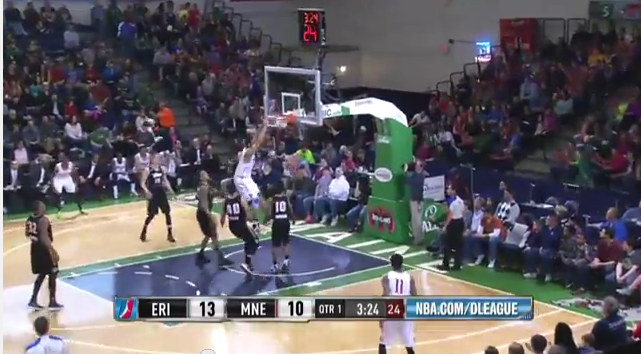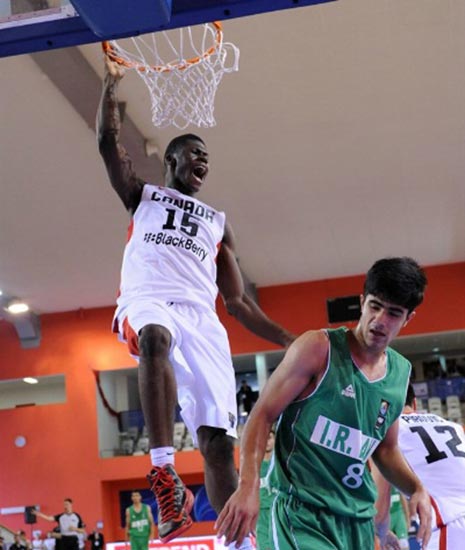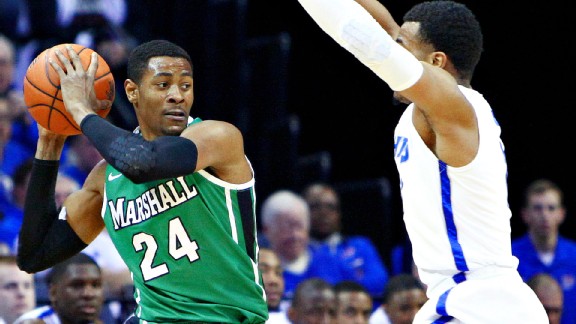 |
| Norvel Pelle (practicing with the USA National Developmental U17 team in 2010) is a long-term project hoping to get selected in the NBA Draft. Pelle played last season with Delaware in the D-League. |
If you have been following these posts on "draft-eligible" prospects over the past week, you may be seeing a connection: all the ones so far have played for the Delaware 87ers. The Sevens, in their first year of existence in the D-League after being the Utah Flash for many years before (and thus an affiliate of the Utah Jazz), have
taken a different approach in terms of assembling a D-League roster with signings ranging from college castoffs (Reeves Nelson, Elijah Pittman) to former high school phenoms (Aquille Carr) to more typical journeyman college players (Kendall Marshall, Matt Bouldin) to even siblings of NBA players (Thanasis Antetokounmpo). It hasn't resulted in a lot of on-court success for the franchise (the Sevens had the worst record in the D-League at 12-38), but it showed that the Sevens could function as a true "minor league" organization to their parent franchise (the Philadelphia 76ers).
And what does it mean to be a "minor league" organization? It means player development comes before on-court success. And no player may have benefited from that more than power forward/center Novel Pelle, who, much like fellow Sevens Antetokounmpo, Pittman and Carr, will be eligible to be selected in this upcoming NBA Draft.
Who is Norvel Pelle?
Out of Price High School in Long Beach, California, Pelle was one of the top center recruits in the nation for the class of 2011.
According to ESPN.com, he was rated as the 12th best center prospect in the nation, and the 77th best prospect overall, and his size, athleticism and recruiting merits earned him a scholarship to St. John's in New York. And it's easy to see why he garnered such high praise and an offer from a Big East school. Pelle's long wingspan (he measured at 7'2.5 at the NBA Draft combine last year) helped make him a force in the paint on both ends of the floor. It was regular to see Pelle either at Price or on the AAU circuit either making spectacular blocks or finishing breathtaking alley oops. Take a look at a MixTape from 2010, which was compiled of AAU highlights of him in the summer entering junior year:
From the tape above, you can see why Steve Lavin was so eager to team him up with Moe Harkless at St. John's and why he has intrigued NBA scouts. But unfortunately for Pelle, off the court issues have seemed to haunt him since he left high school. Before he could play a game for the Red Storm, Pelle was declared ineligible by the NCAA (along with other St. John's commits JaKarr Sampson and Amir Garrett) and thus not allowed to enroll at St. John's in the Fall,
according to Adam Zagoria of Zagsblog. While Sampson and Garrett eventually got eligible and joined St. John's at some point, Pelle re-committed to Iona, but still was ruled ineligible academically by the NCAA and thus unable to play for the Gaels in 2012-2013.
So how did Pelle get to the D-League?
After committing to two schools in two years and unable to play for either due to academic/personal reasons (Pelle claimed in an interview he didn't play last year for Iona because of his mother being in bad shape,
according to an interview with DraftExpress), the center prospect decided to declare for the NBA draft. Pelle participated in the
NBA Draft Combine and a couple of
draft workouts before ultimately pulling his name out of the draft. One of the big rumors surrounding him leaving was that he still had a lot of maturing to do not just as a player, but as a person in general. Take a look at the interview portion of the DraftExpress video below and it is obvious that Pelle interviewed and presented himself like a kid just out of high school, not one ready to make the next step to the NBA.
Not ready for the NBA, Pelle didn't stay in the NBA Draft (he most likely would have gone undrafted if he stayed). Him and his agent looked to be headed to a club team overseas. but Pelle was drafted six overall in the NBA Developmental League Draft and he decided to sign with the team that drafted him, the Delaware 87ers.
How did Pelle do in the D-League?
Pelle's first professional campaign was a mixed bag of sorts. He averaged 5.5 points per game, 3.1 rebounds per game and 1.4 blocks per game on 13.5 minutes per game over the course of 35 games. Those numbers aren't impressive at first glance, and even his per 36 minute stats really don't impress at 15.3 ppg, 8.4 rpg and 3.9 bpg (also 8 fouls per game, as fouls were an issue in his first year). Most of Pelle's value comes from the defensive end, as evidenced by his good block rate in comparison to his team (
21.5% team block rate). That being said, while the strongest part of his game is on the defensive end, he even still has a long way to go. Check out how some of his points in the paint numbers per 36 minutes compare to fellow post teammate Tiny Gallon:
As you can see, on a per 36-minute basis, Gallon proved to be a much better player not only offensively in the paint (16.8 to Pelle's 11.2 PITP), but defensively overall as well. Opponents scored less off turnovers (16.8 to Pelle's 18.5), less off the fast break (13.4 to 14.8) and less in the paint (40.5 to 41.1) against Gallon than Pelle. Considering Pelle is bigger, longer and more athletic than Gallon (though younger, so Gallon has the advantage in playing experience from his time at Oklahoma and in the D-League), it just goes to show that while Pelle has the athletic tools to be a NBA player, he is very early and raw in his development and his numbers showed that last season in Delaware.
While Pelle did battle some injury issues over the year, it was obvious that the time away from the game had an effect on Pelle in his first professional season. Going against players who not only have played college ball, but also some who have had considerable professional experience, Pelle struggled at times to adjust, and he looked hesitant and didn't look to be giving consistent effort at times while on the floor.
A key example of this is this change of possessions showed below
in a late season game against Erie. On these two possessions, Pelle's lack of experience and consistent effort is evident. Let's take a look at the start of the offensive possession below:

BJ Young after a made Erie bucket tries to force the issue with a full court drive. Pelle is filling the lane with him, but his end positioning doesn't help Young. Instead of filling out into the corner or short corner, Pelle positions himself on the block. This shows his lack of playing experience in a couple of ways. First off, if he is in the corner or short corner, he puts his man on defense in a dilemma. If his man helps on D to contest the layup, Pelle will have that easy mid-range or corner 3 shot (most likely mid-range, since he hasn't showed much 3-point ability, as evidenced by his 0.1 3FGA this year). If Pelle's defender stay with him on the mid-range, then Young has an easier time getting the layup or foul. But, because Pelle doesn't drift to the short corner or corner, Pelle's defender has an easier time helping, and Young's shot is heavily contested. Young misses, Pelle, is blocked out by his defender (since he didn't have to commit much in order to help on defense) and Erie gets the ball on the break.

As they are on the break, notice how Pelle is the last guy coming back on defense. Yes, he was furthest underneath the hoop, but Pelle has the athletic gifts to cover a lot of floor with his athleticism and length. Instead, as you can tell from the shot above, he is jogging slowly back, which is putting pressure on the other three defenders knowing that Pelle is either going to come back late or not be there at all on defense. Which results in...
The easy layup for the Bayhawks. Pelle is just above the free throw line instead of in the post, and you can see No. 32 for the Sevens frustrated that no one picked him up. Well, no one picked him up because Pelle should have been there. If Pelle was hustling back, he could have gotten the block from the behind, or at the very least fouled him to prevent the easy bucket and make him earn it at the line. Instead, Pelle's lack of effort costs the Sevens on defense and leads to an easy Erie bucket.
But, growing pains like this are to be expected. Pelle made a major jump from high school ball to professional ball in a short period of time. And considering he was a player who relied on his athletic gifts to carry him during his high school years, its moments like these that can be teachable moments for Pelle going forward as a professional. That being said, when he's in position, Pelle is a strong post defender, as he does have good instincts and uses his length appropriately to block shots and defend the rim. Here's a possession where his defensive ability is used appropriately and helps his Sevens squad.

Pelle is fronting his man who his located slightly above the left block. Pelle notices that the Bayhawk guard has his man (Josh Akognon) beat. So, he sags a little toward the restricted area ready to help out on defense. This awareness showed by Pelle is solid. He's not showing too early (if he shows too early, he allows his defender to cut to the basket for the alley oop), but he's obviously aware and in the right position to help out on defense. Let's see what happens.

The Bayhawk guard drives for the layup and Pelle comes over and blocks his shot with ease. It is moments like this where Pelle excels as a player. He does have a natural gravitation toward the ball on defense, and he is able to block and defend shots in the paint with regularity. Even when you look at his highlight film below, it is his defense that stands out to you, and considering how hard it is to find good post defenders at the professional level, it is easy to see why and how Pelle could find a place at the next level.
Pelle certainly has the tools to be a NBA player, but not right now. He needs more professional experience, more court time and more development, and he would be better served working on those skills in the D-League or perhaps overseas (I think D-League is a better option for him though after his growth last season in Delaware). He lacks a go-to move and struggles to find his game and identity on the offensive end (he wavers too much from being a post player and being a perimeter player and thus, his skills are under-developed on both ends). Furthermore, his inconsistent effort on both sides of the ball is something he needs to work on if he ever wants to make that jump to the NBA. He can't afford to take plays off, especially over an extended 82-game schedule and the increased competition he'll face night in and night out.
But Pelle has the potential, and with some more time, he could develop into something special. His game seems to be a cross of Joel Embiid and DeAndre Jordan, though he doesn't have Embiid's footwork or Jordan's strength. That being said, with a little more development and time, he could end up matching that projection in some sort of way. His defensive abilities and instincts are already a plus (or at the very worst, near a plus), he just needs to round out the other parts of his game.




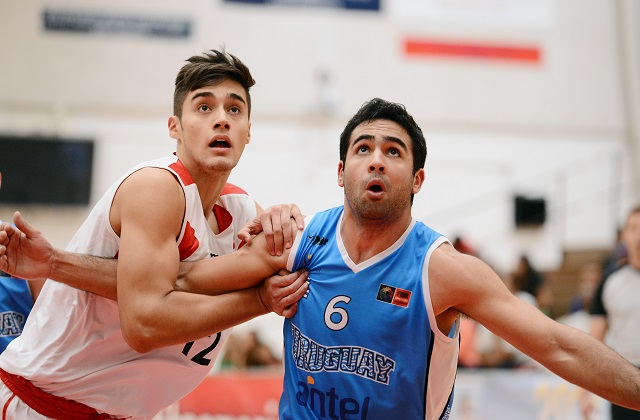






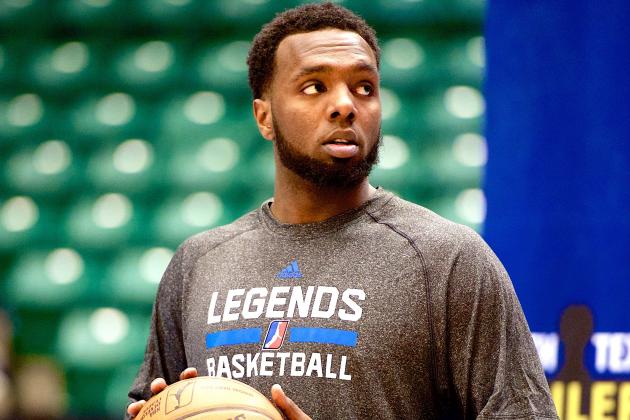





.png)



